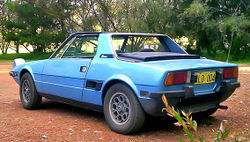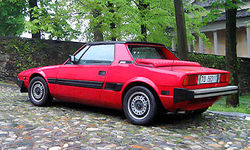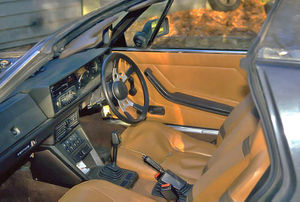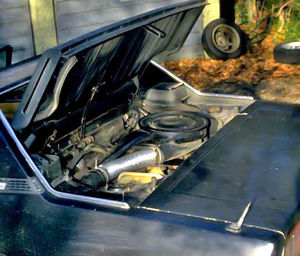Difference between revisions of "Fiat X1/9"
m |
m |
||
| Line 65: | Line 65: | ||
The name stems from the codenames employed by FIAT for their new development projects during the late 1960s and early 1970s. The 'X' projects were subcategorised as X0 (for engines), X1 (for passenger vehicles) and X2 (for commercial vehicles). The first passenger-vehicle developed with this code (X1/1) was released as the FIAT 128 in 1969; other known vehicle-codes are shown in the table below. Though originally envisioned as the '128 [[Spyder|Spider]]', the X1/9 uniquely retained its prototype code through to production. | The name stems from the codenames employed by FIAT for their new development projects during the late 1960s and early 1970s. The 'X' projects were subcategorised as X0 (for engines), X1 (for passenger vehicles) and X2 (for commercial vehicles). The first passenger-vehicle developed with this code (X1/1) was released as the FIAT 128 in 1969; other known vehicle-codes are shown in the table below. Though originally envisioned as the '128 [[Spyder|Spider]]', the X1/9 uniquely retained its prototype code through to production. | ||
| − | {| border=1 cellspacing=3 cellpadding=4 style="float:center; margin:0 0 .5em 1em; width: | + | |
| + | {| border=1 cellspacing=3 cellpadding=4 style="float:center; margin:0 0 .5em 1em; width:600px; background:#505050; border-collapse:collapse; border:1px solid #999; font-size:83%; line-height:1.5; " summary="Infobox Automobile" | ||
|- style="text-align:center; background:#505050;" | |- style="text-align:center; background:#505050;" | ||
|- tr BGCOLOR=darkred | |- tr BGCOLOR=darkred | ||
Revision as of 15:19, 31 October 2009
 Fiat X1/9 at Wheels Of Italy Fiat X1/9 at Wheels Of Italy
| |
| Fiat X1/9 Bertone X1/9 | |
|---|---|
| Manufacturer | Fiat (1972–1982) Bertone (1982–1989) |
| Production | 1972–1989 ~150,000 produced (Fiat) ~50,000 (Bertone) |
| Assembly | Fiat Bertone (after 1982) |
| Predecessor | Fiat 850 Spider |
| Successor | |
| Class | Sports car / Roadster |
| Body style | Two-seater targa |
| Layout | Rear mid-engine, rear-wheel drive |
| Platform | |
| Engine | 128.A (1290 cc) straight-4 138.B (1498 cc) straight-4 |
| Transmission | 4-speed manual 5-speed manual (after 1978, with 1.5 L engine) |
| Wheelbase | 2202 mm |
| Length | 3830 mm |
| Width | 1570 mm |
| Height | 1170 mm |
| Weight | 880 kg - 962 kg |
| Fuel capacity | 47.6 L |
| Related | Fiat 128 Fiat Strada/Ritmo |
| Designer | Marcello Gandini at Bertone |
The Fiat X1/9 is a two-seater mid-engined sports car designed by Bertone and built by Fiat until 1982 and Bertone between 1982 and 1989. X1/9 is correctly pronounced in Italian as Icsunonove: 'x' (ics) 'one' (uno) 'nine' (nove). Phonetically iks-oo-no-nov-eh. English speaking countries pronounce the name as 'x-one-nine', and occasionally (incorrectly) as 'x-nineteen'. Production lasted from 1972 to 1989 with the first official right-hand drive variant arriving in 1976. Before official right-hand drive X1/9s were manufactured by FIAT in 1976, Radbourne Racing were converting left-hand drive X1/9s to a right-hand drive configuration for sale in the UK market. None of these early conversions are believed to remain in existence. The Fiat X1/9 was the first affordable mass produced mid-engined sports car to employ the use of a transverse engine and gearbox originally designed for a front wheel application in a mid-mounted RWD position (a solution later employed by other budget mid engined sports cars). Daniels, J. (1972), 'Fiat X1/9 - Turin's mid-engined sports car', Autocar, December 14 1972:
"There must be thousands of mechanical doodlers who have toyed with the idea of using a transverse in-line engine to power a mid-engined sports car. One or two of the experiments reached an advanced stage..."
"However, not entirely unexpectedly, it has been left to Fiat to produce the definitive small mid-engined sports car, using the engine and transmission pack from the front-engined 128 Coupe."
Ludvigsen, K. (1973), 'Fiat Pulls a Fast One', Motor Trend, April 1973:
"Since the introduction of the first modern small car with front-wheel drive and a transverse engine, the BMC Mini in 1959, the pundits have been pushing for the use of the same principle behind the cockpit to build an inexpensive sports car of advanced mid-engined design. All a maker had to do, they argued, was to put the whole engine-gearbox-diffirential package in the rear and drive the rear wheels with it. Lamborghini's Mura and Ferrari's Dino show how to do it for five-figure prices, but no maker of any size has managed to build such a car that most of us could afford to buy. Until Fiat."
Unlisted Author. (1974), 'Fiat X1/9', Road & Track, May 1974:
"The X1/9 is the first good-looking open mid-engined roadster available to buyers of modest means"
"In designing the X1/9 Fiat pulled a trick others are sure to emulate: installing what was a front-drive power unit in a midship position to drive the rear wheels."
Unlisted Author. (1974), 'Drive an X 1/9 and... Finesse Has a New Meaning!', Sports Car World, April 1974:
"From the moment you slip behind the neat four-spoke wheel and fire up the engine it is obvious all other small sports cars - with the possible exception of the much more expensive Lotus Europa - are hopelessly out of date."
The X1/9 was considered to have excellent handling, and was amongst the first cars to meet the abandoned late 60s U.S. safety regulations. Unlisted Author. (1977), Motor, February 26 1977:
"At its announcement in 1972, Fiat's Bertone styled X1/9 had the distinction of being the first mid-engined sports car destined for volume production"
"the X1/9 is a remarkably safe car with excellent handling and high reserves of roadholding..."
Pre-production
History and packaging
The X1/9 started life in 1969 as a show concept car called the Autobianchi A112 Runabout, with styling by Bertone under chief designer Marcello Gandini. It was designed around the all-new 128 SOHC engine and gearbox (transmission) from the front wheel drive Fiat 128, but used these parts in a radical way, moving the entire transverse drive train and suspension assembly from the front of the 128 to the rear of the passenger cabin, directly in front of the rear axle with the manifolds on the rear face, giving a mid-engined layout. The fuel tank and spare wheel were mounted side by side ahead of the engine directly behind the seats, thus maximising the proportion of the car's weight falling within the wheelbase. This package also left useable stowage areas both front and rear.
Concept car
The prototype car featured a distinctive wedge shape and took many styling cues from contemporary power-boat design. Though the more extreme features of the Runabout such as the C pillar mounted headlights and the small wind-deflector windscreen were lost for the production car, many aesthetic features of the Autobianchi Runabout are readily identifiable on the X1/9. The long flat bonnet (hood) with central indentation, the large front overhang, the wedge shape with prominent C pillar roll-over hoop and the car-length indented plimsoll-line all made the successful transition to the X1/9, giving it a highly distinctive appearance.
Once developed for production, the two-seater featured sharp-edged styling with a wedge shape, pop-up headlights and a removable hard top roof panel (targa top). The removable hardtop is a model of simplicity to remove and replace. The hardtop stores in the front luggage compartment, snug below the front hood, only slightly reducing the space available for front stowage. There was an aftermarket top by Saratoga available, which was made of lightweight clear-smoked polycarbonate, which today is a coveted accessory.
Name
The X1/9 name stands out amongst the contemporary FIAT automobile names for not conforming to the standard (at the time) numerical designations. FIATs of the time were named using a basic numerical system (127, 128, 124, 131 etc) denoting their relative position in the current model line-up, with the X1/9 being the lone exception to this rule.
The name stems from the codenames employed by FIAT for their new development projects during the late 1960s and early 1970s. The 'X' projects were subcategorised as X0 (for engines), X1 (for passenger vehicles) and X2 (for commercial vehicles). The first passenger-vehicle developed with this code (X1/1) was released as the FIAT 128 in 1969; other known vehicle-codes are shown in the table below. Though originally envisioned as the '128 Spider', the X1/9 uniquely retained its prototype code through to production.
| Project Code | Production Vehicle |
|---|---|
| X1/1 | FIAT 128 |
| X1/2 | Autobianchi A112 |
| X1/3 | FIAT 130 |
| X1/4 | FIAT 127 |
| X1/8 | Redeveloped as X1/20. The X1/9 was one of two new FIAT sports cars being designed at the time, the other being the X1/8 which was to be a closed-top 3.0 L sports car styled by Bertone's competitor Pininfarina. The project was redeveloped the X1/20 with a more fuel efficient 2.0 L 4-cylinder engine in response to increasing fuel-prices. The X1/20 was released in 1974 as the Lancia Montecarlo |
| X1/9 | FIAT X1/9 |
| X1/20 | Lancia Montecarlo |
| X1/38 | FIAT Ritmo |
Production
The car was rapidly produced for release in 1972 to replace the aging 850 Spider by Bertone. It was not intended as a replacement for the 124 Sport Spider and production of the 124 Spider and X1/9 continued in parallel for much of the X1/9's life. The car's monocoque body was produced at the Bertone factory in Torino (Turin) and then transported across town to the FIAT's famous Lingotto factory for the installation of the engine and final assembly. In 1982, shortly after the introduction of the 1500 model, complete production of the car was devolved to Bertone and all cars produced from that point were badged as the Bertone X1/9. Bertone badged chassis were slightly different than earlier models in that the footwells were dropped a few inches to enhance legroom and sitting comfort for persons taller than the original design target.
The first models featured a 75 bhp (56 kW) 1290 cc single overhead cam engine with an aluminium head. In this form, the car had less than dramatic performance, hampered somewhat by the surprisingly heavy body shell. The weight largely stems from the immense strength of the bodyshell, built to give the car the same crash resistance in US crash tests as a sedan. Ironically while the X1/9 passed these tests, many standard US models of the day failed them, and eventually the test criteria were relaxed. However, the design was complete by then and so the bodyshell stiffness is considerable for a car of its type, and it also allows power plants of much greater power to be fitted without modification of the standard shell.
US Sales of X1/9s
There were essentially three editions of X1/9 sold in the USA: 1974 cars, 1975-78 cars, and 1979-87 cars.
1974 USA cars were largely the same car FIAT shipped to the rest of the world: body-hugging bumpers, 1290cc engine, and 4-speed transmission.
1975-78 USA cars were unique to the US market. In order to meet USA low-speed crash test standards, these cars were fitted with "ladder-style" impact absorbing bumpers front and rear. In order to meet USA evaporative and exhaust emission standards, FIAT took much the same technical approach as most US carmakers and cars were fitted with Exhaust Gas Recirculation valves to lower combustion temperatures thus reducing Oxides of Nitrogen emissions, and were fitted with AIR pumps that pumped fresh air into exhaust ports, aiding in further combustion of hydrocarbons. An activated charcoal system was implemented to absorb evaporative emissions. The performance of the 1290cc engine suffered: these cars were rated at 63HP.
In 1979 USA cars received the same powertrain make-over that FIAT provided to the rest of the world: an increase in displacement to 1498cc and a 5-speed transmission based on that fitted to the FIAT Strada. 1979 USA cars retained the previous emission controls. Model years 1980 and 1981 saw a transition from carburetion to Bosch L-Jetronic fuel injection, with the changeover coming in 1980 for cars sold in California and a gradual changeover for "federal" cars from late 1980 to 1981 model years. The combination of Fuel Injection (FI), a catalytic converter and unleaded gasoline allowed these cars to meet California and later federal emission standards. FI cars were rated at 75HP.
In 1979 USA X1/9s also received both exterior and interior design freshening. Eliminated was the "tacked on" look of the previous crash bumpers in favor of a more integrated, body-conforming square-shaped aluminum bumpers, front and rear, as well as a new front grille and airdam treatment. Inside, the instrument panel and dash redesign moved the heating and ventilation controls from the center console up to the main dash, more cleanly packaged the radio into the center dash area, and added a glovebox on the passenger side.
During 1982, FIAT decided to end its presence in the USA. FIAT turned over marketing and support of the X1/9 to International Automobile Importers, Inc., headed up by Malcolm Bricklin, and turned over full production duties to Bertone. 1983 was a transition year for the orphaned X1/9, which thereafter was sold as the "Bertone X1/9." To their credit, IAI and Bertone continued to make cosmetic, comfort, and reliability enhancments to the X1/9, such as a state-of-the-art body rust resistance treatments, revised seating to accommodate taller drivers, and a modernized electrical system for 1984 models. However, FIAT's virtual abandonment of the X1/9 dashed any hopes of the car ever getting what it needed from the start, the engine power the chassis so richly deserved.
US sales of the X1/9 nosedived in the final few years, and 1987 was the last year that IAI imported X1/9s to the USA. However, local registration practices in some states titles cars based on the year sold, so there were some "1988" and "1989" Bertone X1/9s.
For the U.S. market, additional emission control equipment and large safety bumpers were added, which sapped performance even more — an increase of engine capacity to 1498 cc with 85 bhp (63 kW) partially dealt with this. While the engine itself was widely regarded as a fine design, the fact was that the car was rather heavy for its power (though light by modern standards) at about 2250 lb, despite its small size and sports car aspirations.
The last production models were named the Gran Finale and sold over the 1989/1990 period. They were a dealer modification of the Special Edition (commonly abbreviated to SE) of 1988/1989, with the addition of a rear spoiler and Gran Finale badges.
Racing
Abarth
The FIAT subsidiary Abarth, in 1973, developed the Abarth X1/9 Prototipo to replace the 124 Spider Abarth as FIAT's main rally car. Ultimately, the parallel 131 Abarth project was chosen over the X1/9 as the main rally competition platform.
The X1/9 Prototipo used an 1840 cc engine (a bored 1600 cc 124 derived unit) with a custom 16v cylinder head fed by twin 44 mm Weber IDF carburettors. Externally the cars sported flared wheel-arches, a small "duck tail" spoiler and an F1 style air intake designed to feed the carburettors cool air from above the cars roof. All the X1/9 Prototipos were raced in the traditional Abarth lime-green/yellow and orange/pink colour scheme.
The prototype nature of the X1/9 Prototipo project means that the exact number of cars produced is impossible to define. Components and entire body-shells were routinely swapped and replaced as part of the development process, but it is believed that 5 genuine cars were produced.
Dallara
In 1975 the X1/9 was chosen by Dallara to enter the World Championship for Makes (in the Group 5 Special Production class). The car featured a modified X1/9 engine with a custom 16v cylinder-head and fundamental suspension and body/monocoque alterations, the most obvious of which are the massively flared wheel-arches and the over-sized rear wing.
Technical information
Paint codes
Paint codes for Mica Red (408) and Mica Blue (407) (1988 to 1989) are not listed in Fiat paint catalogues (they are Bertone colours) but are listed in Volvo paint catalogues. The colours used on the contemporary Volvo 780 are identical to those used on the X1/9 (even using the same 408/407 codes) as the two cars were produced, and painted, by Bertone in the same factory at the same time.
| FIAT and Bertone Paint Codes | |||
|---|---|---|---|
| Year | Description | Code | Name |
| 74-76 | Green | 358 | - |
| 74 | Yellow | 272 | - |
| 74 | Blue | 426 | - |
| 74 | Orange-Red | 474 | - |
| 75-76 | Yellow | 297 | Giallo |
| 75-76 | Sunset Orange | 299 | Tramonto Arancio |
| 75 | Green | 397 | - |
| 77-78 | Metallic Green | 390 | - |
| 77-78 | Metallic Orange | 190 | - |
| 77-80 | Metallic Blue | 447 | - |
| 78-81 | Yellow | 275 | - |
| 78-82 | Metallic Black | 813 | Nero Met |
| 78-83 | Orange-Red | 171 | Rosso Arancio |
| 79-80 | Metallic Light Red | 853 | Rosso Met |
| 79-81 | Gold | 589 | - |
| 80-81 | Silver | 656 | Argenti |
| 80-81 | Metallic Mid Blue | 835 | - |
| 82-85 | Silver over Metallic Charcoal | 656 / 900 | Argenti / Grigio Scuro Met |
| 83 | Yellow over Black | ? / ? | - |
| 84-85 | Metallic Champagne over Metallic Brown | 866 / 791 | Colorado Brown Met / Dark African Sand Met |
| 85-86 | Red over Metallic Charcoal | 171 / 900 | Rosso / Grigio Scuro Met |
| 85-86 | Metallic Light Blue over Metallic Mid Blue | 872 / 835 | Polar Ice Met / Blue Met |
| 86-87 | Black | 601 | Nero |
| 86-87 | Metallic Red | 861 | - |
| 86-87 | Metallic Taupe over Black | 809 / 601 | Grigio Chiaro Met / Nero |
| 86-87 | Red over Black | 886 / 601 | Rosso / Nero |
| 86-88 | Red | 886 | Rosso |
| 87 | Metallic Light Blue | 881 | Azzuro Met |
| 87 | White | 224/F | Bianco Corfu |
| 88 | Metallic Grey (Gunmetal) | 224.668-039B | Grigio Metalizzato |
| 88-89 | Yellow | 572.225-113B | Giallo Cerdo |
| 88-89 | White | 574.064-474B | Bianco Cassablanca |
| 88-89 | Red | 574.183-535L | Rosso Karmin Rot |
| 88-89 | Metallic Dark Red (Mica Red) | 224.129-408B | Rosso Micalizzato |
| 88-89 | Metallic Dark Blue (Mica Blue) | 224.845-407B | Blu Micalizzato |
Criticism
The X1/9 was not properly developed for production, and a reputation for problems dogged the model throughout its remarkably long life. The confined space of the engine compartment meant that routine maintenance was often skipped, and it also led to problems with overheating. A cooling fan was added for the carburetor, which otherwise would get so hot fuel would vaporize in the float chamber, leading to fuel starvation. USA cars with Bosch L-Jetronic fuel injection had an equivalent cooling fan assembly in the rear trunk, the fan operating after engine shutoff to blow exterior cool air onto the fuel injectors and intake manifold to aid in hot restarts. Early models were also prone to premature rusting to an extent that it endangered the security of the steering rack. There were also problems with rapid wear of the transmission, and, in particular, failure of the reverse gear.
As with most mid-engined cars, the normally excellent handling became more challenging with wet or slippery conditions as the front wheels could struggle to gain grip under the relatively light front end of the car.
See also
- Porsche 914, a contemporary mid-engined targa two-seater.
- Matra Bagheera, a contemporary mid-engined three-seater.
- Pontiac Fiero, another mid-engined two-seater.
- Toyota MR2, another mid-engined two-seater.
External links
- Son of Xweb Forums - Since 1999, the world's largest English language X1/9-specific forum
- Xweb 1.0 Archives - Archives of older Xweb discussion topics, hosted on N54
- www.icsunonove.it - The Italian based X1/9 enthusiasts web site
- UK X1/9 Owners' Club - UK based owners' club with forum (paid membership required)
- Filipinetti X1/9 - All about the first X1/9 racecar from Scuderia Filipinetti
- The Bertone Runabout concept-car - History by Tobias Berger
- 1969 Bertone Runabout Information
- The Greek Fiat Bertone x1/9 Club
- The Fiat X1/9 Wiki
| <- Older Models | Fiat car timeline, European market, 1980s - present | |||||||||||||||||||||||||||||||||||||||
| Type | 1980s | 1990s | 2000s | 2010s | ||||||||||||||||||||||||||||||||||||
| 0 | 1 | 2 | 3 | 4 | 5 | 6 | 7 | 8 | 9 | 0 | 1 | 2 | 3 | 4 | 5 | 6 | 7 | 8 | 9 | 0 | 1 | 2 | 3 | 4 | 5 | 6 | 7 | 8 | 9 | 0 | 1 | 2 | 3 | 4 | 5 | |||||
| City cars | 126 | Cinquecento | Seicento (1998-2005) / 600 (2005-2010) | |||||||||||||||||||||||||||||||||||||
| 500 | ||||||||||||||||||||||||||||||||||||||||
| Panda I | Panda II | |||||||||||||||||||||||||||||||||||||||
| Supermini | 127 | Uno | Punto I | Punto II | ||||||||||||||||||||||||||||||||||||
| Grande Punto | Punto Evo | |||||||||||||||||||||||||||||||||||||||
| Small family car |
Ritmo | Tipo | Bravo / Brava | Stilo | Bravo II | |||||||||||||||||||||||||||||||||||
| 131 | Regata | Tempra | Marea | Linea | ||||||||||||||||||||||||||||||||||||
| Albea | ||||||||||||||||||||||||||||||||||||||||
| Large family car | 132 | Argenta | Croma I | Croma II | ||||||||||||||||||||||||||||||||||||
| Coupé | Coupé | |||||||||||||||||||||||||||||||||||||||
| Roadster | 124 Spider | Barchetta | Barchetta | |||||||||||||||||||||||||||||||||||||
| Sports car | X1/9 | |||||||||||||||||||||||||||||||||||||||
| Panel van/Leisure activity vehicle | Fiorino I | Fiorino II | Fiorino III | |||||||||||||||||||||||||||||||||||||
| Doblò | ||||||||||||||||||||||||||||||||||||||||
| Mini SUV | Sedici | |||||||||||||||||||||||||||||||||||||||
| Mini MPV | Idea | |||||||||||||||||||||||||||||||||||||||
| Compact MPV | Multipla | |||||||||||||||||||||||||||||||||||||||
| Large MPV | Ulysse I | Ulysse II | ||||||||||||||||||||||||||||||||||||||
| Van | Daily* | Scudo I | Scudo II | |||||||||||||||||||||||||||||||||||||
| Ducato I | Ducato II | Ducato III | ||||||||||||||||||||||||||||||||||||||
| Mini Pickup | Strada | |||||||||||||||||||||||||||||||||||||||
| Off-road | Campagnola (1107) | |||||||||||||||||||||||||||||||||||||||
| *Rebadged Iveco model | ||||||||||||||||||||||||||||||||||||||||



